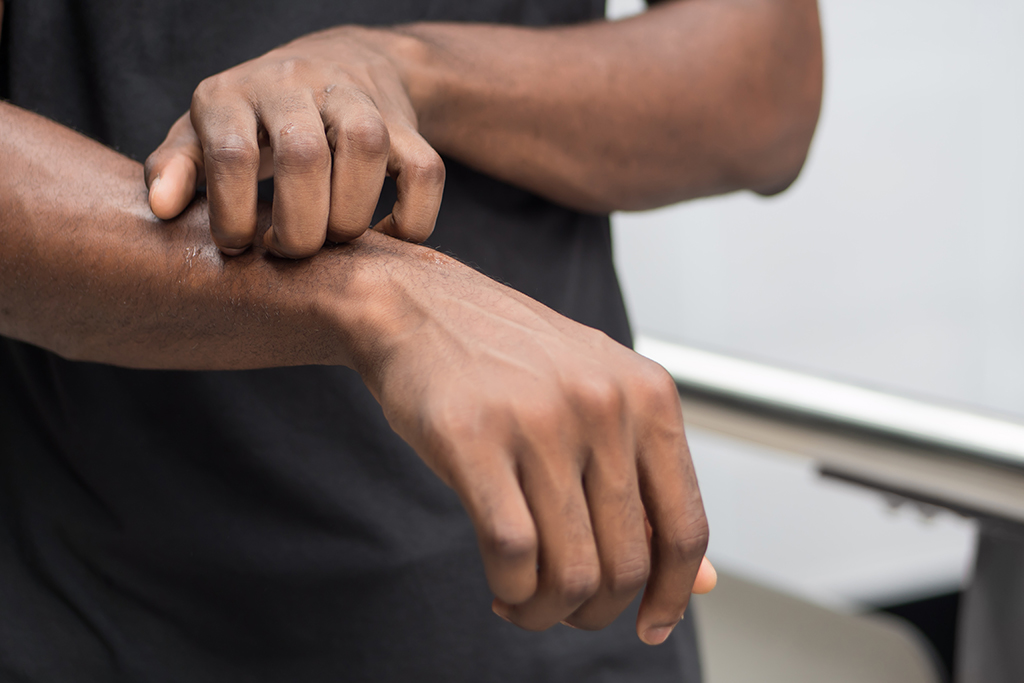
Photo by 9nong at Shutterstock
Winter weather in Southlake, TX, often brings cold, dry conditions that present a challenge for our skin. Heaters generally blow dry air that irritates skin indoors, while cold air and wind irritate skin outside. People with pre-existing skin conditions may see exacerbated symptoms during colder months.
Regular skincare routines may not be entirely effective during cold weather. Freezing temperatures outdoors are usually countered by very warm indoor environments, and moving between the two extremes puts a great deal of stress on our skin. Schedule an appointment with a dermatologist if your skin needs extra care during cold snaps.
Winter Rash
Although this may seem odd, skin loses moisture content faster in cold weather than during hot summer months. The outer layer of skin consists of dead skin cells and oil. Low humidity, strong winds, and low temperatures can damage the outer layer of the epidermis, which leaves underlying layers unprotected.
Hot showers can also disrupt the natural oils necessary for moisture retention. Excessively dry skin often develops patches of irritation described as a winter rash. Winter rash is very common in cold climates. People are more likely to develop winter rash if they have a history of other skin conditions, such as eczema, rosacea, dermatitis, sensitive skin, or allergies. Tell your https://compassiondermatology.com/ about any previous acute or chronic skin conditions.
A winter rash can appear anywhere, but it usually affects the hands, arms, or legs. Your dermatologist may diagnose winter rash through a combination of medical history, physical examination, and a process of elimination to rule out allergies. Common symptoms include:
- redness
- swelling
- flaky skin
- sensitive skin
- small raised bumps
- blisters
Skin Conditions Aggravated by Cold Weather
Seborrheic Dermatitis
Seborrheic dermatitis is characterized by a reddened scalp and loose flakes of dry skin resembling dandruff. Although dandruff only occurs on the scalp, seborrheic dermatitis can occur on any part of the body with hair. Cold, dry weather aggravates this condition and may increase flaking.
Raynaud’s Disease
Raynaud’s disease affects tiny arteries that carry blood to the skin. The arteries narrow and restrict blood flow. The skin on the fingers and toes feel numb and cold due to inadequate circulation. As the disease progresses, fingers and toes change color and sharp, stinging pain may occur. Call a dermatologist if you experience any of these symptoms after exposure to cold air.
Psoriasis
Psoriasis is a chronic condition with sporadic flare-ups that last weeks or months in between periods of remission. Skin cells multiply approximately 10 times faster than normal during a flare-up. Excess cells die and create patches of raised red plaques of scaly or flaky skin.
The most common sites of psoriasis are the elbows, trunk, knees, and scalp. Exposure to sunlight may relieve psoriasis symptoms to some extent. A dermatologist can use phototherapy units to direct specific wavelengths of light to manage psoriasis as well. Reduced sunlight in Southlake, TX, during winter months, can trigger psoriasis flare-ups.
Eczema
Eczema appears as red, irritated skin with small bumps. The affected area is usually uncomfortable and itchy. Try not to scratch irritated areas. Scratching can break the skin and lead to bleeding or infection. Many say there isn’t any permanent cure for eczema, but a dermatologist can help you manage the condition and take steps toward healthier skin. Flare-ups are more common during colder months because of rapid temperature changes between indoor and outdoor environments. Keeping indoor temperatures as low as possible may reduce the frequency and severity of flare-ups, but this isn’t always practical.
Protect Your Skin
Avoiding cold, dry air is the best way to avoid worsening skin conditions, winter rash, and other cold-related effects. This is not realistic for most people, but your dermatologist can help you keep your skin healthy during cold snaps.
UV Rays
The thought of sunburn in cold weather may not be obvious, but ultraviolet rays are a risk in all seasons. The Skin Cancer Foundation states that snow reflects up to 80% of UV light. You may be exposed to more UV rays during the winter months because reflected rays hit twice. Winter clothing often covers most of our bodies, especially while wearing mittens or gloves, but our faces aren’t usually covered. Ask your dermatologist if sunblock is necessary during your daily routine.
UV rays are stronger at high altitudes, so participating in winter sports may require extra precautions. Many people wear thermal face masks to protect themselves from outdoor temperatures during outdoor sports. Face masks protect skin from UV rays as well.
Moisturizer
Moisturizers are the most important tool for protecting skin in cold weather. A high-quality moisturizer locks water content into your skin. Apply moisturizer to your hands, face, and other exposed areas several times per day. Make sure you apply moisturizer after washing your hands or face. Petroleum jelly creates an excellent barrier over your skin to retain moisture. You can try petroleum substitute products if petroleum jelly itself is too greasy, heavy, or uncomfortable.
Natural Oils
Natural oils are getting quite a bit of attention in the field of health and beauty products. Common oils such as olive, coconut, and argan oil, can moisturize and soothe dry skin. Vegetable shortening was once used as a folk remedy. Shortening is solid at room temperature. It may moisturize and protect the skin, but shortening is so thick it can only be used before bed.
Oils can trigger an allergic reaction, such as contact dermatitis, even if you’ve never had a problem with the same oils in your diet. A dermatologist can administer allergy skin tests to pinpoint the cause of a reaction.
An allergic reaction to one type of oil doesn’t mean you can’t use other moisturizing oils. Consult Compassion Dermatology for any skincare concerns. Your dermatologist can also help you develop a personalized cold weather skincare routine.


